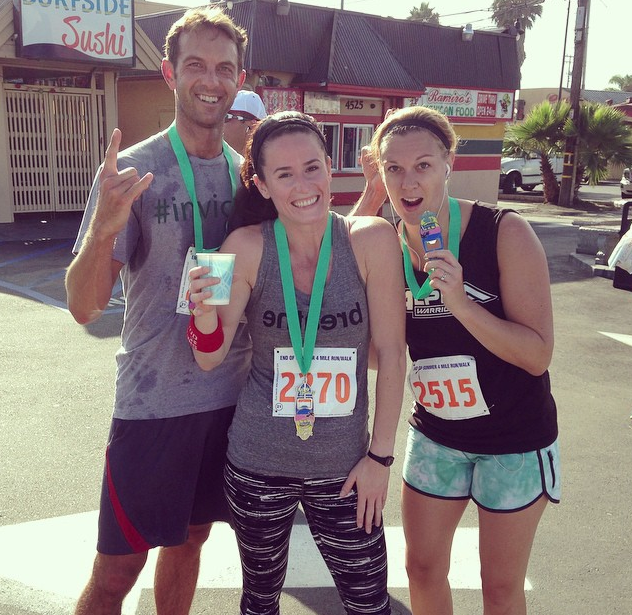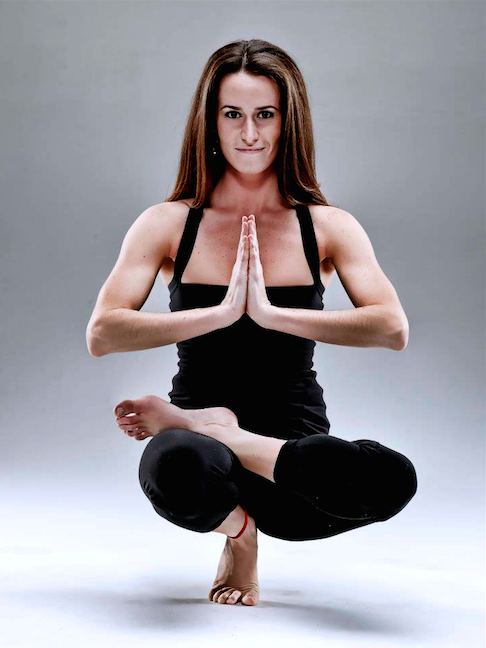3 Ways Meditation Has Made Me a Better Athlete
By Bridget Regan
**Note: As part of our Fall ‘Look Good, Feel Good’ Challenge, Bridget will be leading a meditation class with Q&A on Saturday, October 4th at our Point Loma location from noon – 1:30pm. Open to all challenge participants and competitive athletes!**
When I first tell people I’m a meditation teacher, the looks on their faces usually range from confusion (“Aren’t you supposed to smell like incense and enlightenment?”) to nervous apprehension (“Shoot… I hope she didn’t see me pick my nose a second ago.”) I kid you not: I’ve actually had people take the beer they’re holding and slowly hide it behind their back in the fear of being judged.
The funny thing is that, in my experience at least, people who practice meditation are some of the least judgmental you’ll find. Because meditation (particularly mindfulness, the kind I teach) is a practice of learning to be okay with whatever is happening or whatever you’re feeling in a particular moment, the result is usually a person that’s a lot more understanding, relaxed, and quite frankly – happy.
This is why over the years, it’s not only been a priority for me to help people learn to live more mindful, stress-free lives, but also to help them understand that you don’t have to be a Himalayan monk to reap the benefits of meditation. And you definitely don’t have to put down the I.P.A.!
And there’s a bonus, too. Not only does meditation help us become less judgmental, it also has huge physical benefits as well. For example, here are three ways that meditation can change the way you live and train – in the end, making you a stronger and more effective athlete.
1. Mindful Mechanics
As I mentioned, mindfulness meditation is a practice of training your mind to be acutely aware of anything and everything that’s happening right now, and to notice these things without judging them as good or bad (which leads to stress). For example, during a seated mindfulness meditation practice you’ll often focus on your breathing: how it feels, what it sounds like, if it’s deep or shallow, etc. Through this process of noticing things that you’d normally overlook, you naturally leave less space for the mind to wander, and you become very conscious of the richness of the moment – even when you’re seemingly just sitting doing nothing!
I’ve incorporated this same idea of acute awareness into my workouts too, as something I refer to as “mindful mechanics.” Think of a back squat: Once you know the basic steps of performing a squat, it’s pretty easy to just go through the motions and get the bar up. From the outside, it even still looks like a back squat. But it’s another thing entirely to focus your awareness on each muscle group as you go, engaging each one before moving to the next. It makes the squat much more challenging, and in the end also provides a more structurally sound and supported lift.
The simplest way to introduce mindful mechanics into your workout is to start with your warm up stretches: Instead of haphazardly blasting out a few “good mornings” or Samson stretches while you think about strategy for the challenge ahead, stay present with your stretching. Move slowly and methodically, feeling each muscle as it moves into place and engages, breathing out as you deepen a stretch and breathing in as you release it.
2. Mindful Eating
In the past ten years there seems to have been such a huge focus on what we’re eating, but not so much on how we’re eating – and for the most part, it ain’t pretty. Even those of us with the “healthiest” diets will inhale our food, attempting to avoid the discomfort of feeling hunger, only to end up with the awful feeling of having overeaten…or worse, not even remembering the meal we just had!
Eating mindfully means slowing down, even before the food is in front of you. It’s noticing the first signs of hunger before your stomach growls, and even then, exploring if it’s really hunger or if it’s thirst or even boredom. Then, once we’ve determined that it’s hunger and/or it’s time to eat, we do so slowly, first noticing the way the food smells, how the first bite tastes, and what it feels like to chew. This may seem like a lot of work for a single bite of food, but it’s actually no more work than you’re already doing. Instead, now you’re just being aware of what’s happening instead of attacking your meal in autopilot, Cookie-Monster-style.
A big part of eating mindfully is also realizing that in the end, food = fuel. Our mind creates a lot of unnecessary attachments to food (which you can read about in another of my blog posts, here), and when you couple these associations with mindless eating, you end up feeling chronically unsatisfied, and constantly chasing fulfillment through food.
3. Mindful Body Awareness
Similar to the way we can think about food as fuel to be enjoyed and appreciated (and not something to be emotionally attached to), it’s possible to think of our bodies as vehicles for navigating this crazy planet – and less of our bodies as who we are. (You: “Okay, NOW we’re getting into the really hippie stuff.”) But from a mindfulness perspective, it’s actually pretty literal: The body is a vessel with sensations to be noticed, and not something we should solely identify ourselves with. But at the same time, the body should be noticed without judgment about its size, strength, or appearance, and enjoyed because of the amazing vessel that it is.
The light bulb moment for me was this: Realizing that I wasn’t my body (i.e., not tying my happiness to the state of my body) meant that when my body was in less-than-optimal shape, it didn’t necessarily mean I was less-than-optimal. This thought allowed me to separate myself from the vessel, and to care for it more objectively: with fuel and with movement that would serve its health and strength. At the end of the day, the body is a direct reflection of the mind: When the mind is strong, the body will follow.
Bridget Regan is a writer & meditation teacher living in San Diego, CA. Check out her blog at Mindful.Life.Style or follow her on Instagram (@bridgetreganwrites) for more of her perspective on modern-day mindfulness.


I’m surprised to find that meditation has helped with one’s eating habits. My spouse and I are considering joining a group meditation class. We’ll look into what options are available to determine the most beneficial services. https://ichakras.com/meditation-classes/
Hi there! Great article you have, I would also want to share my thoughts that Meditation indeed has positive effects not only in the body but also in the mind, a total holistic wellness that brings us to know our inner-self better. It gives us a peace of mind that helps us have a much better perception about our lives.
Our advocacy is to promote the positive effects of meditation, yoga and inner wellness.
Help us, visit our website at http://www.iamthechangeiseek.org and also http://www.goodreads.com/kathleensuneja
Thank you and have a great day!.
Looking to start
meditation? Not sure what method can work for you? Learn why most people
fails. https://finderscourse.iljmp.com/1/fccomplete1
All very wise observations. I find the mindful body awareness concept very intriguing. Thanks Bridget!
Big thanks to Crossfit Invictus for the opportunity to write for such an awe-inspiring community. I’m here and happy to answer any questions – leave a comment! – Bridget